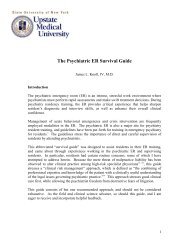Synchronicity Cambray
Synchronicity Cambray
Synchronicity Cambray
You also want an ePaper? Increase the reach of your titles
YUMPU automatically turns print PDFs into web optimized ePapers that Google loves.
The notion of a resonant, mirroring capacity of mind that can<br />
bring knowledge of our environment has a particular parallel in Western<br />
psychology that can be explored through the concept of empathy.<br />
The purpose is not to suggest an equivalency between empathy and<br />
the mind of the sage but rather to engage the evolving Western understanding<br />
of empathy in the hope that we may find intersections with<br />
Eastern attitudes on cultivating the mind that were helpful to Jung in<br />
his formulation of the synchronicity principle.<br />
The articulated idea of empathy is of surprisingly recent vintage.<br />
The original term is German, Einfühlung, literally “feeling-into,”<br />
coined by the art historian Robert Vischer only in 1873 and distinguished<br />
from an older notion, Mitgefühl, sympathy. 6 Vischer’s work<br />
inaugurated the psychological approach to the study of aesthetics. His<br />
idea was to relate the dynamics within a work of art to the subjective<br />
experiences stemming from somatic and affective states engendered<br />
by viewing the art. Aesthetic pleasure was seen to be based in<br />
a melding of self and object, something he derived from the study of<br />
the projection of self in dreams. Vischer’s Einfühlung thus involved<br />
an unconscious, involuntary act of transference of self into objects.<br />
All of this antedates Freud’s psychoanalytic theorizing by twentyfive<br />
years. “Empathy” as the translation of Einfühlung entered the<br />
English language in 1909 through the work of the American psychologist<br />
Edward B. Titchener. 7<br />
The German philosopher of aesthetics, Theodor Lipps, in publications<br />
from 1900 to 1913 and beyond, further developed the psychological<br />
understanding of empathy by proposing the inner imitation of the<br />
actions of others as crucial for generating empathic experiences. 8 For<br />
Lipps human empathy included responses to gestures, facial expressions,<br />
and tone of voice, all carrying emotional qualities and capable<br />
of enlivening the same emotions in the viewer. However, Lipps also<br />
insisted that empathy is not an inference from analogy but a unique<br />
form of knowledge.<br />
Both Jung and Freud derived their views on empathy directly from<br />
Lipps. 9 Jung equated Lipps’s perspective to a central feature of the<br />
analytic process: “As a rule, the projection transfers unconscious contents<br />
into the object, for which reason empathy is also termed ‘trans<br />
( 70 ) Chapter 4









